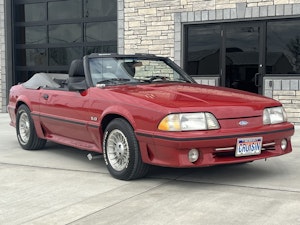Media | Articles
The 2004-2006 Pontiac GTO was a road rocket and sales bomb
It was two enthusiast dreams come true in one car. An American icon was reborn and, ironically, a formerly forbidden fruit was its foundation. Yes, an Australian-built muscle car was repurposed for American tastes. For those and other reasons, the 2004-2006 Pontiac GTO should have been a home run, to apply a baseball metaphor to cars. But it wasn’t. Here’s what happened.
Enthusiasts hadn’t forgiven Pontiac for letting the fabled GTO die out as a gussied-up Ventura compact in 1974. Yet, even as American muscle cars were fading in the 1970s, there were rumblings from the Southern Hemisphere. The success of the Australian Mad Max movies helped spark interest in cars from Down Under, including the Ford Falcon that Max drove, and the Monaro V-8 coupe from General Motors’ subsidiary, Holden. Both of those cars used American-bred V-8s. Without the regulations facing American carmakers at the time, the Australian subsidiaries kept cranking out muscled-up road warriors.
Flash forward to the dawn of the 21st century. American muscle was back, but there were some hiccups. GM ended production of the Chevy Camaro and Pontiac Firebird after 2002. Pontiac, the “excitement division,” was suddenly out of the performance business.
GM president Bob Lutz is credited with the idea of turning the Holden Monaro into a new-wave Pontiac GTO. The top version already had a Corvette LS1 engine. It also had a six-speed stick, independent rear suspension, a sleek coupe shape and was sized a bit larger than the Camaro and Mustang.
In a sense, the Monaro – or at least its German sedan cousin – had already been to the States as an Opel Omega dressed up as the Cadillac Catera. It bombed, and a key reason, other than reliability issues, was its bland design.
Marketplace
Buy and sell classics with confidence
But importing the Monaro wasn’t quite so simple. In addition to converting the Monaro to left-hand drive, GM had to rework a few things to bring the car up to U.S. safety standards, including moving the fuel tank to a safer spot above the trunk floor. As a result, the GTO had a small trunk.
Furthermore, attempting to brand the Monaro as a “Pontiac,” designers gave it a hastily contrived split grille front fascia and some GTO badges. GM also tried mimicking the ‘64 GTO’s exhaust sound, but American musclecar fans didn’t like the wimpy-looking dual tailpipe tips exiting on the left side. The GTO didn’t even get fake hood scoops at first, but those would eventually come.
So, the new GTO didn’t look like a GTO. But it ran like no other Pontiac GTO before it. The 2004 model came with the 5.7-liter LS1 packing 350 horsepower. Forget comparisons to the 350-horse Pontiac V-8 in the classic models; the 2004 car’s horses were net and all accounted for.
A four-speed automatic was standard, and the six-speed stick was optional. Either way, the 2004 Goat could eat asphalt. Typical road tests pegged 0-60 at about 5.5 seconds and a 14-second or quicker quarter-mile at about 105 mph. That was out of the box. The GTO’s handling and ride were praised, one of the benefits of independent rear suspension.
“If you want to shop around for other true four-seaters that can run with this Pontiac, you’ll be visiting BMW and Mercedes-Benz showrooms and be looking at $50,000-plus window stickers,” said Edmunds in its road test.
Comparatively, the GTO seemed a bargain at about $34,000, but that was well above the $25,000 GM thought it would be; exchange rates got much of the blame. Strong initial demand sparked dealers to demand even higher prices, but the gouging didn’t last long. As sales slowed, the GTO soon came with discounts. A Mustang GT cost a lot less, was about as fast and, well, looked like a Mustang should look.
The new GTO was planned to be a niche model, but the niche was smaller than hoped. Pontiac dealers sold just under 13,600 GTOs for 2004, against an earlier projection of 18,000. When the 2005 GTO arrived it had the 6.0-liter LS2 with 400 horsepower and 400 net lb.-ft. of torque. It also got standard hood scoops, split rear tailpipes and brake upgrades.
With a six-speed GTO, Car and Driver got 0-60 in 4.8 seconds and the quarter-mile in 13.3 seconds at 107 mph. That was hauling, but it wasn’t enough to turn the sales tide. After three years, Pontiac sold just under 41,000 of what was its quickest, best handling GTO ever. That was long enough for the suits.
Yet GM tried again, importing the GTO’s four-door sibling, the Holden Commodore, to the U.S. as the Pontiac G8 in 2008. It won praise but also failed to sell, and it went down with the Pontiac ship when GM euthanized the division in 2009. That same year, Chevy’s fifth-generation Camaro arrived using the Holden-developed “Zeta” platform. And the Holden Commodore, meanwhile, came back, first as the Chevy Caprice Police Patrol Vehicle (PPV) and today as the Chevy SS for civilians.










